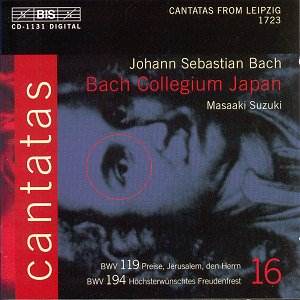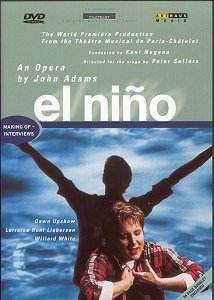 Composer: Johann Sebastian Bach
Composer: Johann Sebastian Bach
Works: Cantata No. 194, “Höschesterwünschtes Feudenfest”, BWV 194; Cantata No. 119, “Preise, Jerusalem, den Herrn”, BWV 119
Performers: Yukari Nonoshita, soprano (BWV 194); Yoshie Hida, soprano (BWV 119); Kirsten Sollek-Avella, alto (BWV 119); Makoto Sakurada, tenor; Jochen Kupfer, baritone (BWV 194); Peter Kooij, bass; Bach Collegium Japan, Masaaki Suzuki
Recording: September 2000, Kobe Shoin Women’s University, Japan
Label: BIS
The sacred cantatas of Johann Sebastian Bach stand as monumental achievements in the Baroque canon, embodying both the theological depth and the musical ingenuity of their composer. Volume 16 of Masaaki Suzuki’s ambitious project to record the complete cantatas features two significant works from Bach’s Leipzig period: Cantata No. 194, composed for the inauguration of the organ at Störmthal, and Cantata No. 119, crafted for the council election in 1723. These cantatas not only highlight Bach’s extraordinary ability to fuse music and text but also his skill in adapting his writing to the specific needs of each occasion.
Suzuki’s interpretation is characterized by a delicate orchestral palette and a small but effective choral ensemble, which lends a transparency to the textures. The choice to utilize a twelve-voice choir for BWV 194 and a sixteen-voice choir for BWV 119 allows for an intimate yet rich sound that emphasizes clarity and balance. This approach, particularly relevant in the context of BWV 194, enhances the pastoral and celebratory spirit of the work. Baritone Jochen Kupfer’s performance in “Was des Höchsten Glans erfüllt” exemplifies this; his voice flows effortlessly over the intricate oboe lines, creating a seamless tapestry of sound. However, while Kupfer’s interpretation is commendable, it is Yukari Nonoshita’s soprano that draws attention. In her first aria, “Hulf, Gott, dass es uns gelingt,” she occasionally struggles with balance against the orchestra, her light timbre at times competing with the instrumental forces. Yet, her subsequent aria, a duet with bass, showcases her ability to navigate both the airy and the more robust qualities of her voice, ultimately revealing a nuanced expressiveness.
Cantata 119, with its grand orchestration that includes trombones and timpani, presents a contrasting texture. Here, the majestic opening French overture sets a regal tone that is effectively realized by the Bach Collegium Japan. The choral writing, dense and intricate, is executed with remarkable precision, even within the confines of a small choir. The choir’s ability to convey both power and subtlety is evident in the lengthy choral movements, where the balance between choral and orchestral forces is meticulously maintained. Suzuki’s direction ensures that the singers retain their individuality while contributing to the collective sound, a feat that is particularly impressive given the complexities of Bach’s writing.
The recording itself is noteworthy for its engineering quality. The sound is warm and well-defined, allowing the listener to appreciate the interplay of voices and instruments without feeling overwhelmed by any single element. However, the small print of the accompanying notes poses a significant accessibility issue, detracting slightly from the overall experience of engaging with the music and its context.
Masaaki Suzuki’s continued commitment to exploring Bach’s cantatas yields yet another rewarding installment in this series. The two cantatas featured in this volume are masterful examples of Bach’s craftsmanship, and the performances are executed with a level of care that honors the music’s integrity. This recording not only reinforces Suzuki’s stature as a leading interpreter of Bach but also serves as a fresh perspective on these works, inviting both seasoned listeners and newcomers to delve deeper into the richness of Bach’s choral and orchestral language.



